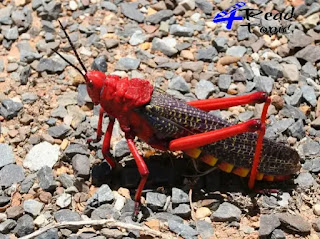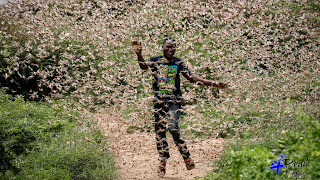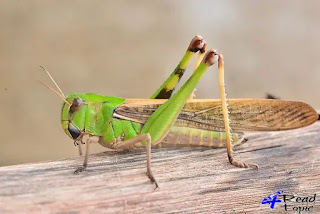Why do these insects portend a disaster in some countries?
Is humanity destined to face the greatest challenge from small organisms this year, after the emerging crisis of the Coronavirus, which has been holding the world's breath for months?
A question raised by the intense battle against the deadly virus since last December, and one to which the Food and Agriculture Organization refers today (FAO) with its talk about the upcoming war against locust swarms.
The organization talked about a long battle, threatening a food security crisis, and the direct cause of this is these small organisms that come on green and dry land.
The World Organization expected that the second wave of desert locust attacks will include countries in East Africa, reaching India and Iran, confirming the expectations of many confiscations that This year's following wave will be the worst.
The threat of locust swarming is real. in the huge amount of destruction, they cause on farms and the environment in general, as one swarm can eat the same amount of food that thirty-five thousand people eat per day, according to experts.
Locusts can eat up to 90 miles of cultivated land in a single day.
It's a risk that can be magnified by a factor of hundreds.
Therefore, any slackening in efforts to confront locust swarms on the part of the countries of the world will increase the size of the hunger pandemic, which was exacerbated by the spread of the Corona epidemic.
- What are locusts?
Locusts have been feared and revered in the course of history. Related to grasshoppers, these bugs shape widespread swarms that unfold throughout regions, devouring plants and leaving serious agricultural harm in their wake. Since the Pharaohs ruled historic Egypt, locust plagues have wreaked havoc on societies, and they continue to do so now.
- Behavior and lifestyles cycle
Locusts seem like regular grasshoppers—most notably, they each have huge hind legs that assist them to hop or jump. They once in a while share the solitary way of life of a grasshopper, too. However, locust conduct can be something else entirely.
Solitary locusts are pushed together in patchy areas of land with closed vegetation during dry spells. This unexpected crowding releases serotonin in their central frightened structures that makes locusts extra sociable and promotes speedy moves and extra assorted appetite.
When rains return—producing moist soil and plentiful inexperienced plants—those environmental prerequisites create the best storm: Locusts start to produce swiftly and come to be even extra crowded together. In these circumstances, they shift definitely from their solitary lifestyle to a crew lifestyle in what’s referred to as the gregarious phase. Locusts can even alternate coloration and physique form when they pass into this phase. Their persistence will increase and even their brains get larger.
Locusts can come to be gregarious at any factor in their lifecycle. When a locust hatches, it emerges as a non-flying nymph with no wings, which might be solitary or gregarious. A nymph can additionally exchange between conduct phases earlier than turning into a flying person after 24 to ninety-five days.
- THE LIFE OF A LOCUST
Locusts go thru several phases earlier than maturing into flying adults. At any factor in that procedure, they can flip gregarious—if prerequisites are right. Transformations in their conduct and bodily characteristics can subsequently be reversed, or they can persist and be exceeded on to offspring.
- Swarming
Locust swarms are usually in movement and can cowl great distances—some species can also journey eighty-one miles or extra a day. They can continue to be in the air for lengthy periods, generally taking nonstop journeys throughout the Red Sea. A swarm flew from northwest Africa to the United Kingdom in 1954, while another flew from West Africa to the Caribbean for a day in 1988. of extra than 3,100 miles in simply 10 days.
Swarms of locusts destroy vegetation and cause the most serious agricultural devastation, which can result in hunger and starvation. Locusts can be found in many parts of the world, although they are most prevalent in Africa's subsistence agricultural areas these days.
------ WHERE SWARMS OCCUR ------
The barren region locust, which has the greatest monetary impact, threatens one-fifth of the Earth's land area and one-tenth of the global population. Over 60 international locations are prone to swarms. Locusts in the solitary segment occupy and breed in smaller regions. From 1986 through 1989, North Africa and the Middle East were devastated by the ultimate major pandemic.
------ Preventing a plague ------
Weather patterns and historic locust data assist specialists to predict the place swarms may form. Once identified, a place is sprayed with chemical compounds to kill locusts earlier than they can gather.
- Desert locusts
The wilderness locust (Schistocerca gregaria) is an infamous species. Found in Africa, the Middle East, and Asia, this species inhabits a vicinity of about six million rectangular miles, or 30 countries, at some point of a quiet period. Locusts can spread across 60 countries and cover a fifth of the Earth's geographical surface during a plague when large swarms descend upon a place. Desert locusts are a serious problem. plagues threaten the monetary livelihood of a tenth of humans.
In less than half a square mile, a desert tract locust swarm can cover 460 square miles and contain between forty and eighty million locusts. Each locust can swallow its own body weight in plants each day, therefore a swarm of this size would consume 423 million kilos of flowers per day. To put it into context, a swarm the measurement of Paris can consume the identical quantity of meals in one day as half of the populace of France.
- Prevention
There are many motives why it’s tough to manage or stop a plague of locusts, which include the remoteness and breadth of the areas throughout which they unfold and restricted assets in some of the affected countries. But specialists can seem at previous climate patterns and historic archives to perceive the areas the place swarms would possibly manifest and spray these areas with chemicals.
Some professionals fear that locust plagues will aggravate a warming world. Rising sea temperatures are inflicting extended bouts of moist weather, inclusive of a surge of uncommon cyclones in Japanese Africa and the Arabian Peninsula





Comments
Post a Comment
You can write your comment here